
HRH The Duke of Gloucester today visited QE, as the reigning Sunday Times State Secondary School of the Year prepares to celebrate its 450th anniversary early next year.
 Members of the School’s Combined Cadet Force flanked the main entrance and the senior rugby team provided a sporting backdrop as the Duke arrived for his visit, during which he marked the anniversary by planting an oak tree and by presenting a specially embroidered banner to Headmaster Neil Enright.
Members of the School’s Combined Cadet Force flanked the main entrance and the senior rugby team provided a sporting backdrop as the Duke arrived for his visit, during which he marked the anniversary by planting an oak tree and by presenting a specially embroidered banner to Headmaster Neil Enright.
The visit had an eye to the future as well as the past: the Duke was given a demonstration of VEX Robotics – QE is a multi-time UK champion and was the first UK school to win a World Championship title – and even tried out driving the robots himself.
He came to QE almost exactly 90 years after another royal visit, by HRH The Prince George, Duke of Kent, who opened the new buildings – still in use as QE’s Main Building – following the School’s relocation from its historic Tudor Hall site in Wood Street, Barnet.
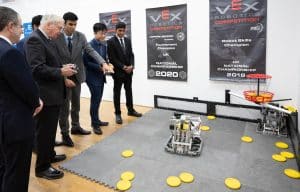 Following the visit, Mr Enright said: “It was a tremendous honour and my great pleasure to welcome HRH The Duke of Gloucester today. With the anniversary fast approaching, there was much to show him, including the School’s original 1573 Charter signed by Elizabeth I, our Ties through Time installation of 232 School photographs from the 1880s until comparatively modern times, and, to bring things right up to date, the robots and our new Music building, opened in May.
Following the visit, Mr Enright said: “It was a tremendous honour and my great pleasure to welcome HRH The Duke of Gloucester today. With the anniversary fast approaching, there was much to show him, including the School’s original 1573 Charter signed by Elizabeth I, our Ties through Time installation of 232 School photographs from the 1880s until comparatively modern times, and, to bring things right up to date, the robots and our new Music building, opened in May.
“The Duke showed a keen interest in everything, and I know our roboteers will be especially delighted that he was brave enough to try his hand at the controls of two of their creations.”
On his arrival, the Duke was presented to the Headmaster by Martin Russell, Representative Deputy Lieutenant of the London Borough of Barnet and a former QE parent.
 He was then introduced to:
He was then introduced to:
- Barrie Martin, MBE (Chairman of Governors and Chairman of the Friends of Queen Elizabeth’s)
- Nick Gaskell (Vice-Chairman of Governors)
- The three Deputy Heads: Anne Macdonald (Academic); David Ryan (Pastoral) and Tara O’Reilly (Operations)
- School Captain (head boy) Theo Mama-Kahn, and Senior Vice-Captains Ansh Jassra and Antony Yassa, all of Year 13.
The Duke was shown the charter and Royal Seal, together with original artefacts from the 1932 royal visit drawn from the School’s archives. The materials were introduced by Jenni Blackford, Curator of QE Collections and Head of Library Services, and two Year 13 boys involved in the work with the archives, Ishaan Mehta and 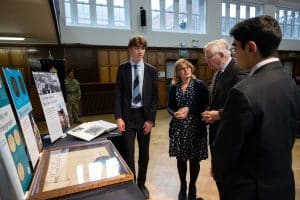 Gabriel Gulliford.
Gabriel Gulliford.
The Headmaster then gave a formal welcome to the Duke in front of 100 selected pupils in the Main School Hall. He said: “Your Royal Highness, it is my honour and privilege to offer you the warmest welcome on behalf of the Elizabethan community…2022 has been a year full of accomplishment at the School. We have had our status as an outstanding school confirmed by Ofsted, been named State Secondary School of the Year by The Sunday Times, and opened The Friends’ Recital Hall and Music Rooms – the latest enhancement to our campus, built from the generosity of our School community. You could say it has been our annus mirabilis.”
QE’s Senior Barbershop group sang the hymn Abide with Me while the new School banner was brought into the hall by a representative of the CCF. Commissioned in advance of the 450th anniversary service being held in Westminster Abbey on 24th March 2023, the banner was passed to the Duke, who presented it to the Headmaster.
 After visiting the Ties through Time photographic installation and enjoying the robotics in the School’s Conference Centre, the royal party headed to the new Music building to watch rehearsals for this Thursday’s Winter Concert under the watchful eye of Director of Music Ruth Partington.
After visiting the Ties through Time photographic installation and enjoying the robotics in the School’s Conference Centre, the royal party headed to the new Music building to watch rehearsals for this Thursday’s Winter Concert under the watchful eye of Director of Music Ruth Partington.
Then it was back to the front of the School before the Duke walked down the drive, lined by Year 7 pupils, stopping close to the gates to plant the anniversary oak tree. It is intended that the tree, which has been marked with a commemorative plaque, will come into full leaf for the first time at the School in the spring of 2023.
The tree will also form part of The Queen’s Green Canopy project inaugurated to mark Queen Elizabeth II’s Platinum Jubilee. Senior Vice-Captain Antony Yassa read a short extract from the wording of a new anthem composed for the anniversary year by internationally renowned composer, Howard Goodall, which is to receive its debut performance in Westminster Abbey in March: “Let us fill this place with hope. Face fate and fortune in our stride. That like an oak, we draw our strength from ancient roots spread deep and wide. From ancient roots spread deep and wide.”
Pupil representatives from the School’s Eco Network and its six Houses placed soil at the base of the tree, with the Duke invited to complete the process.

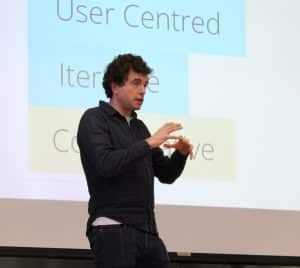 Mr Greig, who works for Deloitte Digital (part of the global Deloitte financial services and consultancy group) as its Chief Disruptor, made it through the snow to give a lunchtime lecture about his work, which involves working with new technologies to understand how they can benefit clients.
Mr Greig, who works for Deloitte Digital (part of the global Deloitte financial services and consultancy group) as its Chief Disruptor, made it through the snow to give a lunchtime lecture about his work, which involves working with new technologies to understand how they can benefit clients.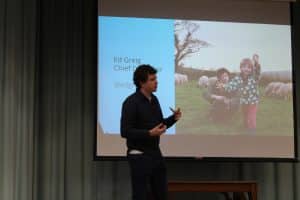 He gave the real-life example of a prosthetic arm for a six-year-old girl, where the issue was not merely the functionality of the limb, but making sure the girl would actually wear it by ensuring its design was fashionable and appealing, so that she would want to put it on.
He gave the real-life example of a prosthetic arm for a six-year-old girl, where the issue was not merely the functionality of the limb, but making sure the girl would actually wear it by ensuring its design was fashionable and appealing, so that she would want to put it on.
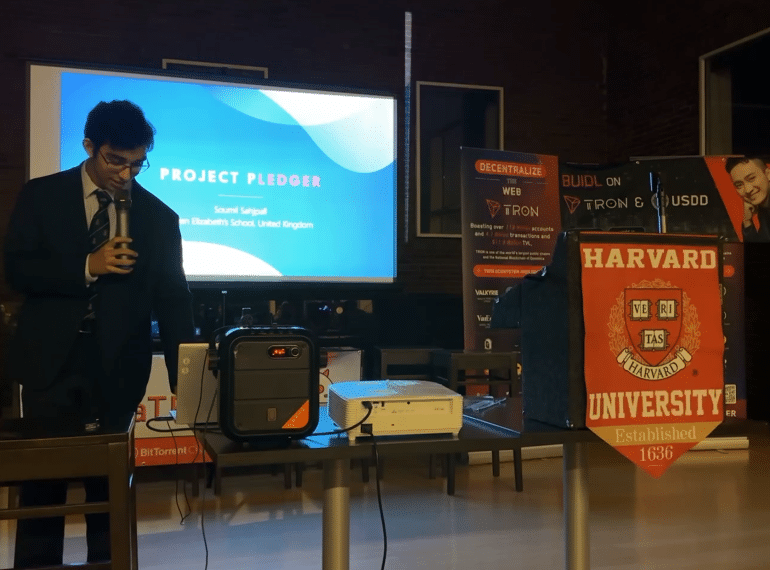
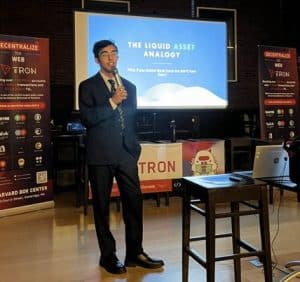 During his trip to the US, Soumil rubbed shoulders with Ivy League students as he developed blockchain software for cryptocurrency TRON in a coding marathon. His app earned him an ‘honourable mention’ from the judges, who placed him in joint-ninth place out of 55 teams.
During his trip to the US, Soumil rubbed shoulders with Ivy League students as he developed blockchain software for cryptocurrency TRON in a coding marathon. His app earned him an ‘honourable mention’ from the judges, who placed him in joint-ninth place out of 55 teams.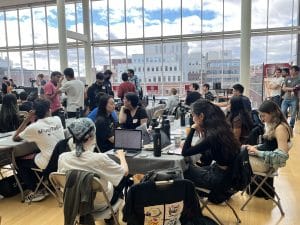 TRON, a leading cryptocurrency with a current market value of $5 billion, set a brief to develop a dAPP, or “decentralized app” – that is, software that runs on the blockchain, as opposed to on a server hosted by technology giants such as Amazon or Microsoft.
TRON, a leading cryptocurrency with a current market value of $5 billion, set a brief to develop a dAPP, or “decentralized app” – that is, software that runs on the blockchain, as opposed to on a server hosted by technology giants such as Amazon or Microsoft. “I found out about this hackathon with relatively short notice, so I competed solo,” he said. “I was relatively confident in my abilities and knew I’d still be having lots of fun, so that was all right. The average team size was around four members – with a maximum of five – so I was at a disadvantage.”
“I found out about this hackathon with relatively short notice, so I competed solo,” he said. “I was relatively confident in my abilities and knew I’d still be having lots of fun, so that was all right. The average team size was around four members – with a maximum of five – so I was at a disadvantage.”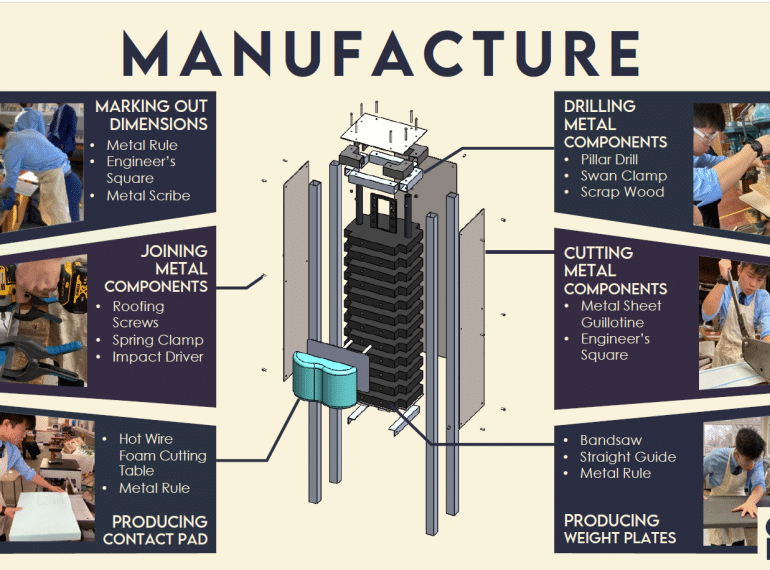
 Darren Lee and Yash Patel laboured for months through a gruelling selection process for the scholarships, which will now provide them with financial and mentoring support during their A-level studies.
Darren Lee and Yash Patel laboured for months through a gruelling selection process for the scholarships, which will now provide them with financial and mentoring support during their A-level studies. The process included an engineering aptitude test and an online interview, during which candidates had both to make a presentation and to respond to technical engineering questions.
The process included an engineering aptitude test and an online interview, during which candidates had both to make a presentation and to respond to technical engineering questions.
 Members of the School’s Combined Cadet Force flanked the main entrance and the senior rugby team provided a sporting backdrop as the Duke arrived for his visit, during which he marked the anniversary by planting an oak tree and by presenting a specially embroidered banner to Headmaster Neil Enright.
Members of the School’s Combined Cadet Force flanked the main entrance and the senior rugby team provided a sporting backdrop as the Duke arrived for his visit, during which he marked the anniversary by planting an oak tree and by presenting a specially embroidered banner to Headmaster Neil Enright. Following the visit, Mr Enright said: “It was a tremendous honour and my great pleasure to welcome HRH The Duke of Gloucester today. With the anniversary fast approaching, there was much to show him, including the School’s original 1573 Charter signed by Elizabeth I, our Ties through Time installation of 232 School photographs from the 1880s until comparatively modern times, and, to bring things right up to date, the robots and our new Music building, opened in May.
Following the visit, Mr Enright said: “It was a tremendous honour and my great pleasure to welcome HRH The Duke of Gloucester today. With the anniversary fast approaching, there was much to show him, including the School’s original 1573 Charter signed by Elizabeth I, our Ties through Time installation of 232 School photographs from the 1880s until comparatively modern times, and, to bring things right up to date, the robots and our new Music building, opened in May. He was then introduced to:
He was then introduced to: Gabriel Gulliford.
Gabriel Gulliford. After visiting the Ties through Time photographic installation and enjoying the robotics in the School’s Conference Centre, the royal party headed to the new Music building to watch rehearsals for this Thursday’s Winter Concert under the watchful eye of Director of Music Ruth Partington.
After visiting the Ties through Time photographic installation and enjoying the robotics in the School’s Conference Centre, the royal party headed to the new Music building to watch rehearsals for this Thursday’s Winter Concert under the watchful eye of Director of Music Ruth Partington.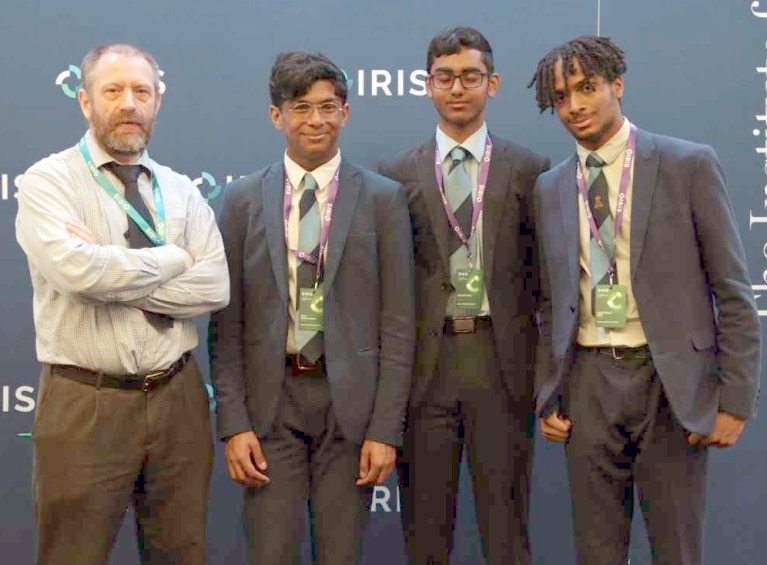
 Mr Brooke, who accompanied them to the conference, said: “Every step of the process was driven by the initiative of the boys, and it was fitting that one of the guests on the Scientist Panel that concluded the event, Dr Harshnira Patani, Senior Scientist Pharmacology at MSD (one of the world’s leading pharmaceutical companies), singled out the boys’ presentation as her highlight of the conference, making particular note of their use of machine learning.”
Mr Brooke, who accompanied them to the conference, said: “Every step of the process was driven by the initiative of the boys, and it was fitting that one of the guests on the Scientist Panel that concluded the event, Dr Harshnira Patani, Senior Scientist Pharmacology at MSD (one of the world’s leading pharmaceutical companies), singled out the boys’ presentation as her highlight of the conference, making particular note of their use of machine learning.”
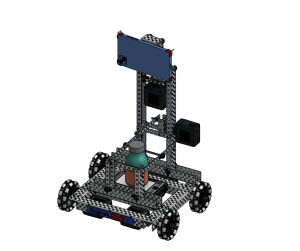 Their Buginator robot is designed to help farmers combat swarms of pests, thus protecting precious ecosystems while the farmers remain safely inside.
Their Buginator robot is designed to help farmers combat swarms of pests, thus protecting precious ecosystems while the farmers remain safely inside.